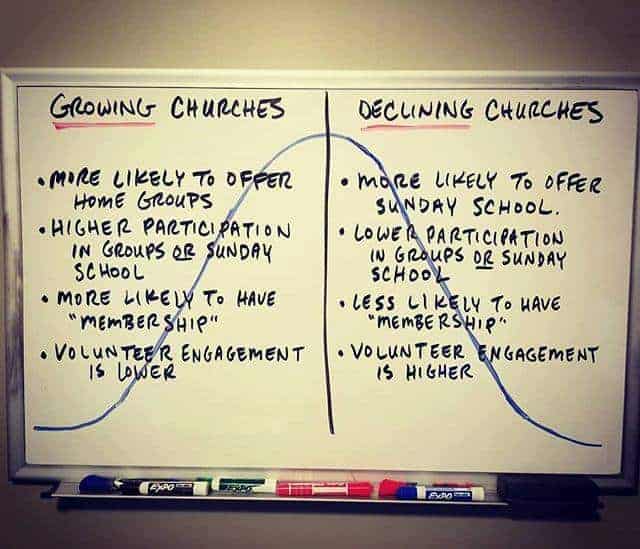Here Are the Trends I’m Seeing
I’m fortunate to lead a great team of people who serve hundreds of churches each year through coaching and consulting engagements. Every time we work with a church, we collect data to help us assess the ministry’s health. That process benefits the individual churches we serve, but it also gives us access to an incredible wealth of data.
I recently dug into the numbers from the nearly 200 churches we connected with over the last 12 months. I was curious to learn what, if any, differences there were between growing and declining churches.
To do this, I collected the data from all the churches that had grown in worship attendance by five percent or more over the last year. In case you’re curious, there were 77 churches in that category. I compared that data with the churches that had declined in attendance by five percent or more in that same period. There were 52 of those churches. I found some really compelling data.
I’ll unpack more about the differences in upcoming articles, but today I wanted to focus on the difference around ministry reach. Based on the data, these are the trends we’re seeing:
- Declining churches are more than twice as likely to be offering multiple styles of worship. It’s challenging to create compelling worship experiences when you’re trying to offer multiple different styles.
- Growing churches are more likely to offer modern/contemporary worship than declining churches. In fact, the data also shows that churches that do not offer any modern/contemporary worship but have a traditional worship service have declined by 5% in attendance over the last year.
+ MORE RESOURCES
- Growing churches tend to be more outward-focused. They’re offering worship experiences where people are more more likely to invite someone new…nearly 60% more than declining churches.
- Growing churches are more likely to be use a multisite strategy. It’s not a huge difference. The bigger story here may be the 12% of churches who appear to be “MultiStuck” because they’ve embraced multisite but are experiencing decline. This confirms our experience that multisite isn’t the magic bullet for church growth. Multisite helps healthy churches grow faster, and it helps unhealthy churches decline faster.
- Growing churches are attracting a higher percentage of kids. This may be because growing churches tend to do a better job of reaching younger families.
- Declining churches are attracting a higher percentage of students. We believe there are a couple of reasons why this is happening. First, declining churches tend to have older congregants so they are, therefore, more likely to have students in middle or high school. Secondly, growing churches tend to have more compelling “adult” worship experiences that students want to attend; therefore, they aren’t as likely to attend separate student gatherings.
- Growing churches baptize a higher percentage of people than declining churches. In other words, there’s more conversion growth. At The Unstuck Group, conversion growth is one of several factors we use to measure overall church health. It’s encouraging to see churches are growing because they’re spreading the Gospel to people outside the faith.
Just to be clear—this isn’t a comparison of big churches versus smaller churches. This is data that’s comparing the ministry reach of growing churches to declining churches. Both sets of data include churches of fewer than 100 people and megachurches with more than 2,000 people.
In future articles, I’ll highlight some differences in ministry connections, staffing, structure and finances. The rest of the data is just as fascinating.
We’d love to hear your reaction. Participate in the conversation on social media by using the hashtag #UnstuckChurch.








One Comment
Great article but have to disagree on the students at declining churches. Growing churches, in particular, contemporary churches are growing greatly with fantastic Student Ministries which includes relevant biblical messages, great modern worship and the relational aspect that students are looking for. (of course the games and craziness also)
Most growing contemporary churches have a mix of different age groups from younger couples to older couples so students whether high school or middle are attending with their familes.
Churches as examples are Mission Hills in Littleton, CO, Red Rocks Church, Crosspoint City Church Cartersville, GA and Canvas Church in Kalispell just to name a few as I could list many more.